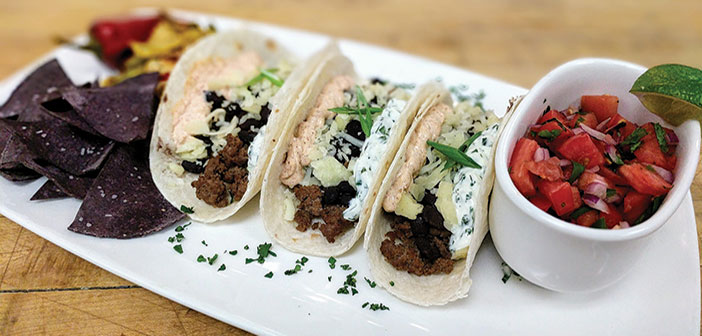The kitchen is the classroom for med students learning about nutrition.
One Friday evening this spring, Mike Makuch, MAT, chair of culinary arts at Johnson & Wales University, gathered with about 20 students in one of his school’s kitchens, surrounded by professional-grade ovens and countless cooking tools.
When Makuch pulled out a cart piled high with chicken, lamb, peppers, onions, bok choy, and more, the students grabbed ingredients, formed groups, and started to conceptualize dishes. For the final class of “Food and Health,” their task was to create a healthy meal for a family of four on a tight budget. But not everyone was a culinary student—many Warren Alpert medical students filled the kitchen as well.
Since a med student and former chef came up with the concept nearly five years ago, “Food and Health” has taught food science, nutrition, and cooking skills to medical and culinary students alike. In each class, students hear a lecture on a nutritional science theme, like whole grains or low sodium, and then venture into the kitchen to explore recipes and techniques with guidance from Makuch and Johnson & Wales students.
“The ultimate hope is that they’re able to build some of these concepts that we teach them in the lab into their practice,” Makuch says. “Hopefully it makes relating to patients that much easier.”
With a recent push from the American Heart Association to better educate med students about nutrition, the limited ways medical schools teach food science are in the spotlight. A 2013 survey uncovered that 71 percent of medical schools fail to provide all the nutrition education hours recommended by the National Academy of Sciences, and 36 percent don’t provide even half, according to the AHA. The advisory—published in April and led by Karen Aspry MD, clinical assistant professor of medicine—points out holes in nutrition education for medical students, and suggests practical, experiential, and interprofessional ways to teach food science.
While medical school curricula may delve into the biology and chemistry of nutrition, they don’t always include more practical aspects of nutrition science, says Paul George, MHPE ’01 MD’05 RES’08, associate dean for medical education and an adviser for the course. “I’d love to see a longitudinal thread around nutrition woven into the curriculum,” he says, adding that he is trying to add some practical nutrition instruction into the fourth year of study.
Course leader Catherine Gannage MD’21 says she rarely sees doctors offer specific ideas to improve the way patients eat. Finding her nutrition education lacking, she took the course to become a better cook and a better doctor. “This is actually some concrete information that I could pass on. I could change my family’s habits,” she says.
Andrew Del Re MD’21, another course leader, says he grew up in an Italian family where food was a centerpiece of culture, and he struggled with his weight in adolescence. After extensive research and changing his exercise and eating habits in high school, his quality of life improved dramatically, along with his grades and musical skills. “People can change their lives through these lifestyle changes,” he says.
Nutrition education is only the tip of the iceberg, Del Re says: “It goes way beyond the transmission of nutrition knowledge.” Though “Food and Health” might only reach students who choose the course as an elective, the student leaders hope to create lasting inspiration for doctors to engage with patients and the foods accessible to them. “If we know the skills in the kitchen, we can transmit those skills to patients,” Del Re says.
The course seeks to cultivate a curiosity and passion for cooking, letting students build confidence in the kitchen. While learning to make hummus, one medical student asked to share a family recipe, which garnered rave reviews. “When I learned how to make hummus, it changed my world forever,” Del Re says. “Forever.”
Going forward, the course leaders hope to include more material about engaging with patients’ food environments: understanding what food is available to them, what foods are central to their cultures, and why they eat the way they do. They aim to teach future doctors creative and practical ways to work around the dearth of fresh, nutritious foods accessible to many patients. Populations of low socioeconomic status warrant particular attention, since they may not be able to afford many healthier options, Del Re says.
“You can give all the nutrition recommendations that you want, but if they’re not able to apply it, then they’ll be stuck,” Makuch says. “That’s the power of food. It’s really transformative.”




